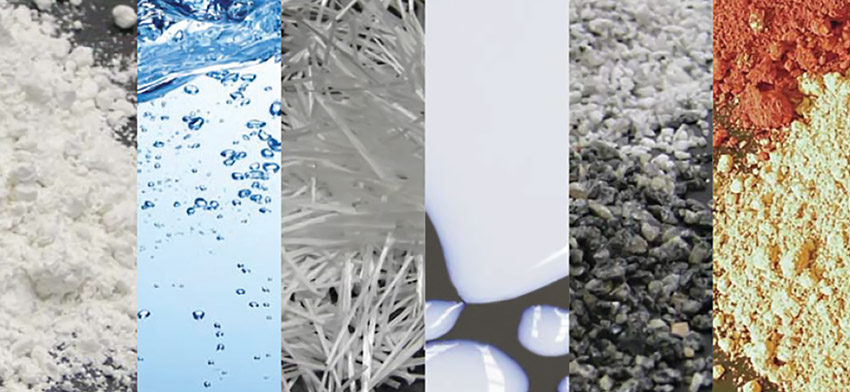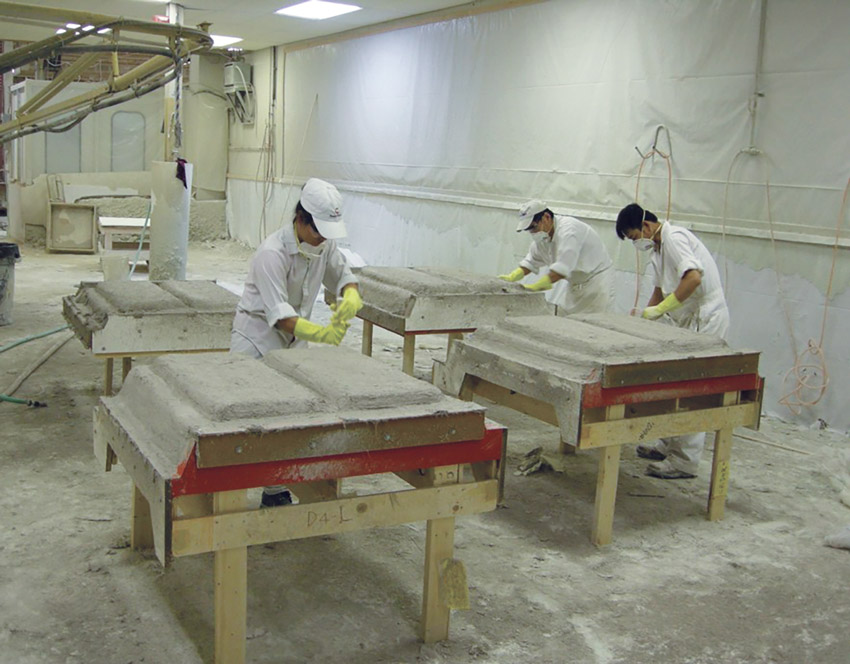Architectural Castings for Walls and Ceilings
Green Building Aspects of Architectural Castings
All building products are routinely reviewed by architects and others for sustainability traits and quite often for how they can help contribute to certification under the LEED green building program or others. Depending on the quantity and size of architectural castings used on a project, the green building contribution could range from minor to very significant. Hence it is worth recognizing the following green building attributes.
Materials and Resources
Architectural castings of all types are engineered to use materials and resources very efficiently. Most are based on combining natural materials in very controlled manners to minimize waste during their manufacture. Further, since parts are supplied to suit field measurements and conditions, there is little or no job-site cutting resulting in no on-site waste. Shipping of the products involves crating on wood pallets and 2-by-4s that can be easily reused or recycled.
From a product life-cycle standpoint, new raw materials are typically used for most castings, but they tend to use a lot less material when compared to full, traditional concrete, stone, or plaster items. Nonetheless, the nature of the raw materials used usually dictates that they are sourced locally and not shipped long distances, helping to reduce the impact of embedded energy in those materials. For recycled content, some post-industrial fillers can be used in castings in certain cases to make the overall impact a bit less as well. The process of forming the castings does not involve any high-heat process so the energy use and impact during fabrication is very controllable. The durability of the castings speaks to their long service life, and their material makeup makes them very suitable for salvage and reuse or recycling at the end of that service life.

The materials used in architectural castings help determine their overall life-cycle attributes contributing to green and sustainable design.
It is worth pointing out the potential positive ripple effect of using architectural castings as an innovation in design in this category. We have already mentioned that castings can use less material than their traditional counterparts, which is significant unto itself. Taking that a step further, the weight of architectural castings is less than solid concrete, stone, or similar materials that they replace. That reduced weight means there is less dead load acting on the structural system, which may mean that steel or other structural framing can be reduced, thus decreasing the amount of material in that framing. By extension, less weight and lighter steel means the foundation system does not need to carry as much weight and can be reduced accordingly. Of course, all of this is very project specific and depends on what the castings are being compared to in terms of traditional construction and materials. However, it would seem that a case can be made that the material benefits go beyond just the castings themselves.
Indoor Environmental Quality
Healthy indoor environments are paramount among many green building rating systems, including LEED, the WELL Building Standard, and The Living Building Challenge. In particular, the use of building materials inside of buildings that do not contain or emit substances that are harmful to human health has been a major motivation behind the creation of these standards and criteria. Their refinement and sophistication have helped define a good-quality, healthy indoor environment.
Architectural castings play well into this situation in that they can be completely prefinished with low-emitting materials that do not contain any urea-formaldehyde or volatile organic compounds (VOCs)—some of the main substances of concern for a healthy indoor environment. Since castings can be prefinished in this way, then no paints, coatings, adhesives, or sealants are needed in some cases. If paint-grade castings are selected, then they will work quite well with no or low-VOC paint and can still help contribute to this category.
Cost Considerations
All discussions of building products and systems eventually get around to the cost of using them. More specifically, they usually focus on comparing the cost of a particular approach to some other alternatives to determine whether or not the project is being done efficiently and will stay within budget. All of those factors can vary widely from project to project, but we can look at some general comparisons, factors that influence price, and the long-term cost beyond the initial cost of using architectural castings.
In general, GFRC is less costly to use than traditional precast concrete because of its thinner profile and other characteristics. Both FRP and GFRC are lighter in weight than precast concrete, which contributes to their overall cost efficiencies. Architectural castings, when used as column covers or surrounds, are generally less expensive than metal surrounds. Beyond these specific comparisons, there are also some general cost saving items that need to be considered. First is the fact that architectural castings can provide a consolidated product (i.e., a single panel with multiple features that would have otherwise been made up of multiple parts), which can reduce labor and installation time on the jobsite. Second, they provide capabilities within the products for some needed traits such as fire resistance, acoustical performance, and prefinishing. In some cases, those traits are superior to some of the more conventional alternatives or to other similar off-the-shelf materials. All of these integrated characteristics eliminates the need for other products to be added.
When designing custom architectural castings into a building, the cost will be directly affected by the number of castings made per mold. Since the cost to make the mold is similar, whether you have one or 50 castings, the mold cost can be thought of as being spread equally over the total number of castings made. Hence if one mold is made and only one casting is fabricated from it, then that one casting will absorb all of the cost of the mold, making it comparatively very expensive. On the other hand if that same mold is used to create up to 10 or more castings, the mold cost is spread across them, and the cost will become more practical. The optimal condition, of course, is to spread the mold cost out over as many castings as possible, say 100 or more, which reduces the cost per casting considerably.

The number of castings made in a particular mold will directly influence the ultimate cost of the castings since the mold cost will be spread out equally across them.
Another consideration in the cost of architectural castings is the degree of detail involved in the cast elements. Keep in mind first that, if there is little to no detail required in the items, meaning they are all flat surfaces, then it can probably be done more economically using gypsum board or other materials. When there is more detail being called for in one or more panels, that is when it makes sense to consider a casting. The degree of detailing (i.e., relief items, decorative accents, artistic shapes, etc.) will have somewhat of an impact, but since the mold is fabricated by computerized techniques, the overall size and shape may be more of a cost driver. The casting needs to be workable too, such that the type of detail doesn’t interfere with removing it from the mold, which could create a more expensive level of difficulty in fabricating.
When it comes to the long-term cost of architectural castings, we have seen that they are very durable and need little, if any, maintenance. That means they can cost less than other products in cleaning and building operation costs over the life of the building. Related to that, most notably on exterior building applications, continuous castings made from large panels is a means to reduce the number of joints and seams. That can dramatically reduce the opportunities for weather to penetrate into the wall system and cause corrosion, damage, or other problems. Avoiding those problems to begin with is always more cost effective than having to repair, maintain, or reseal, weak areas on a facade.
Conclusion
We have explored the range of common architectural castings for both interior and exterior installations and looked at the characteristics of the four most common ones, namely GRG, GFRC, FRP, and cast stone. It has become clear that dramatic or sublime architectural details can be created to enhance an overall design and to address more practical considerations, such as fire performance, acoustics, and durability. Their makeup of predominantly natural materials and their resulting lighter weight contribute not only to easier installation but also toward green and sustainable design and construction. Finally, we have looked at the cost considerations and favorable economics of using architectural castings in buildings. For ceilings, walls, features, accents, details, and other building elements, architectural castings can be a very satisfying and long-lasting choice for all types of commercial and institutional buildings.









